If you’ve ever encountered a network outage and found the error message “Cloudlin down eth1,” you know how frustrating it can be. This issue typically refers to an Ethernet interface (eth1) being down or disconnected in a Cloudlin-based environment, which can result in disruptions to your server’s connectivity. Understanding what “cloudlin down eth1” means and how to troubleshoot it effectively is crucial for keeping your network running smoothly. Whether you are a seasoned IT professional or a beginner managing a server, this guide will walk you through the causes, effects, and troubleshooting steps to get your system back online.
The “cloudlin down eth1” error message usually appears when there is a problem with the network interface configuration, causing your device or server to lose its connection to the network. This could be due to multiple factors such as improper configuration settings, physical hardware issues, or even software problems. To resolve this, it’s essential to identify the root cause and apply the correct troubleshooting steps, which we will explore in this article
What is “Cloudlin Down eth1”?
Before diving into solutions, let’s break down what “Cloudlin down eth1” actually means. The term refers to the status of the eth1 network interface, which is often seen in cloud computing environments like Cloudlin. In networking terminology, “eth1” represents a specific Ethernet interface (the first Ethernet interface after eth0, which is typically the default primary interface). When the interface goes down, it is no longer able to transmit or receive data, disrupting the server’s ability to communicate with other devices on the network.
The error “Cloudlin down eth1” typically means that your server or device is unable to access the internet or local network through the eth1 interface. This can happen for various reasons, such as misconfigured network settings, a disconnected physical cable, or an issue with the network driver. Troubleshooting and fixing this issue is essential to restore proper network functionality.
Common Causes of Cloudlin Down eth1
Several reasons might trigger the “Cloudlin down eth1” error. Some of the most common causes include:
- Cable Disconnection: If the physical Ethernet cable connected to your device is loose or unplugged, the eth1 interface can go down.
- Driver Issues: Outdated or corrupted network drivers can cause the interface to become unresponsive.
- IP Configuration Errors: Incorrect IP address configurations or subnet mask mismatches can lead to network connectivity issues.
- Hardware Failures: Faulty network interface cards (NICs) or other hardware issues can bring down the eth1 interface.
How to Diagnose “Cloudlin Down eth1”
Diagnosing the root cause of the “Cloudlin down eth1” error is the first step in resolving the issue. A systematic approach can help you identify whether the problem is related to hardware, software, or configuration. Here’s how you can begin:
Step 1: Check Physical Connections
Start by inspecting the physical Ethernet cables connected to your server or device. Ensure that the cable is properly plugged into both the device and the network switch or router. If possible, swap out the cable to rule out any issues with the physical connection.
Step 2: Verify Network Interface Status
Use commands like ifconfig (on Linux systems) or ip a to check the status of your network interfaces. The eth1 interface should display as “up” if it’s functioning properly. If it shows as “down,” then the issue lies within the interface itself.
Step 3: Review Logs for Error Messages
Look into system logs (typically found in /var/log/syslog or /var/log/messages on Linux systems) for any relevant error messages. These logs can provide crucial information about why the interface went down and give clues about potential driver or configuration issues.
Resolving Network Configuration Issues
Network configuration issues are one of the most common causes of the “Cloudlin down eth1” error. These issues often stem from incorrect settings in the operating system’s network configuration files. Here’s how to troubleshoot and fix these problems:
Step 1: Check IP Address Configuration
If your eth1 interface has been manually configured with a static IP address, ensure that the IP address, subnet mask, and gateway are correctly set. A mismatch between these settings can cause the network interface to go down. You can verify and adjust the IP settings by editing files like /etc/network/interfaces (on Debian-based systems) or using the nmcli command for systems using NetworkManager.
Step 2: DHCP Configuration
If you rely on dynamic IP assignment via DHCP, ensure that the DHCP client is running properly. A misconfigured or disabled DHCP client could prevent your server from obtaining an IP address, leading to the “cloudlin down eth1” issue. Restarting the network service or manually triggering a DHCP request might resolve the problem.
Hardware and Driver Troubleshooting
In addition to network configuration errors, hardware or driver issues can cause the eth1 interface to go down. Here’s how to address these:
Step 1: Check Network Interface Card (NIC) Status
Inspect the physical NIC connected to the eth1 interface. If you suspect hardware failure, test the device with a different NIC or in a different slot. Additionally, ensure that the NIC is properly seated and functioning.
Step 2: Update or Reinstall Network Drivers
Outdated or corrupted network drivers can also cause the “cloudlin down eth1” issue. Ensure that you are using the latest drivers for your network card. On Linux systems, you can update the driver via package managers like apt or yum. If updating doesn’t resolve the issue, try reinstalling the driver or rolling back to a previous working version.
Advanced Solutions for Persistent “Cloudlin Down eth1” Issues
In some cases, the “Cloudlin down eth1” error might persist even after trying the basic troubleshooting steps. When this happens, advanced solutions are necessary to fully resolve the issue.
Step 1: Reconfigure the Network Interface Manually
You may need to manually reset or reconfigure the eth1 interface. This can involve editing network configuration files directly or using network management tools like ifup or ifdown to bring the interface up and down manually.
Step 2: Restart Networking Services
Restarting the networking services on your system can often resolve lingering issues. You can do this by using commands like systemctl restart networking or service networking restart. This will reset all network interfaces and potentially clear up any issues affecting eth1.
Conclusion
The “cloudlin down eth1” issue is a common problem in network management that can disrupt your server’s connectivity. By understanding the underlying causes and following the troubleshooting steps outlined in this guide, you can diagnose and resolve the problem effectively. Whether the issue is related to network configuration, hardware, or drivers, the key is to approach the problem systematically and apply the right solutions to restore connectivity. With persistence and the right approach, you can ensure that your network interfaces stay up and running smoothly.
Frequently Asked Questions (FAQs)
- What does “Cloudlin down eth1” mean?
It means that the eth1 network interface on your device or server has been disconnected or is malfunctioning, causing network connectivity issues. - How can I check the status of eth1?
You can use commands like ifconfig or ip a on Linux to check the status of the eth1 interface. - What causes the “cloudlin down eth1” error?
Common causes include physical cable issues, network configuration errors, outdated drivers, and hardware failures. - How do I fix “Cloudlin down eth1”?
Troubleshoot by checking physical connections, verifying network configuration, and ensuring drivers are up to date. - Can a misconfigured IP address cause eth1 to go down?
Yes, incorrect IP configuration can prevent the eth1 interface from connecting to the network. - How do I restart the networking service on Linux?
Use the command systemctl restart networking or service networking restart to restart networking services. - What is the difference between eth0 and eth1?
Eth0 is typically the primary Ethernet interface, while eth1 is the secondary one. The numbering depends on the number of interfaces on the device. - How do I update network drivers in Linux?
Use package managers like apt or yum to update the network drivers for your NIC. - What should I do if the “Cloudlin down eth1” issue persists?
If the issue persists, try reconfiguring the network interface manually or resetting the network settings. - Can a faulty NIC cause the “Cloudlin down eth1” issue?
Yes, a malfunctioning or faulty NIC can cause the interface to go down, preventing network connectivity.



